| Crag Hall | |||||||||||||||||||||||||
|---|---|---|---|---|---|---|---|---|---|---|---|---|---|---|---|---|---|---|---|---|---|---|---|---|---|
 Crag Hall | |||||||||||||||||||||||||
| |||||||||||||||||||||||||
Crag Hall is a country house east of the village of Wildboarclough, Cheshire, England and owned by the Earl of Derby.
| Crag Hall | |||||||||||||||||||||||||
|---|---|---|---|---|---|---|---|---|---|---|---|---|---|---|---|---|---|---|---|---|---|---|---|---|---|
 Crag Hall | |||||||||||||||||||||||||
| |||||||||||||||||||||||||
Crag Hall is a country house east of the village of Wildboarclough, Cheshire, England and owned by the Earl of Derby.
It was built in 1815 by George Palfreyman, the owner of a textile printing works nearby. It has since been extended by the addition of large curved bow windows at each end of the entrance front. [1] The house is constructed in brick-sized blocks of brown sandstone, with ashlar quoins and dressings. It is roofed in slate. The house is in two storeys. [2] The entrance front has five bays. [3] In the centre is a raised portico with four Ionic columns. It is approached from each side by a flight of steps. Its base is rusticated and contains three arched recesses. [2] Above the portico is a window with an entablature. About the house, Figueirdo and Treuherz comment that "it has an imposing air of millstone grit solidity". [1] The house is recorded in the National Heritage List for England as a designated Grade II* listed building. [2] Associated with the house are three structures listed at Grade II: the gateway with its wing walls, [4] the retaining wall to the garden terrace, [5] and a wall and summer house in the garden. [6]

Eaton Hall is the country house of the Duke of Westminster. It is 1 mile (2 km) south of the village of Eccleston, in Cheshire, England. The house is surrounded by its own formal gardens, parkland, farmland and woodland. The estate covers about 10,872 acres (4,400 ha).

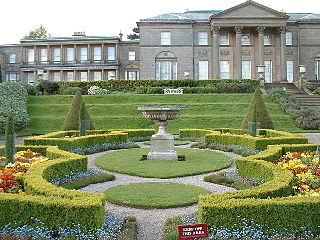
Tatton Park is a historic estate in Cheshire, England, north of the town of Knutsford. It contains a mansion, Tatton Hall, a medieval manor house, Tatton Old Hall, Tatton Park Gardens, a farm and a deer park of 2,000 acres (8.1 km2). It is a popular visitor attraction and hosts over a hundred events annually. The estate is owned by the National Trust, and managed under lease by Cheshire East Council . Since 1999, it has hosted North West England's annual Royal Horticultural Society flower show.
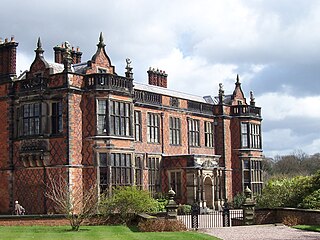
Arley Hall is a country house in the village of Arley, Cheshire, England, about 4 miles (6 km) south of Lymm and 5 miles (8 km) north of Northwich. It is home to the owner, Viscount Ashbrook, and his family. The house is a Grade II* listed building, as is its adjacent chapel. Formal gardens to the southwest of the hall are also listed as Grade II* on the National Register of Historic Parks and Gardens. In the grounds are more listed buildings, a cruck barn being listed as Grade I, and the other buildings as Grade II.

Adlington Hall is a country house near Adlington, Cheshire. The oldest part of the existing building, the Great Hall, was constructed between 1480 and 1505; the east wing was added in 1581. The Legh family has lived in the hall and in previous buildings on the same site since the early 14th century. After the house was occupied by Parliamentary forces during the Civil War, changes were made to the north wing, including encasing the Great Hall in brick, inserting windows, and installing an organ in the Great Hall. In the 18th century the house was inherited by Charles Legh who organised a series of major changes. These included building a new west wing, which incorporated a ballroom, and a south wing with a large portico. It is possible that Charles Legh himself was the architect for these additions. He also played a large part in planning and designing the gardens, woodland and parkland, which included a number of buildings of various types, including a bridge known as the Chinese Bridge that carried a summerhouse.
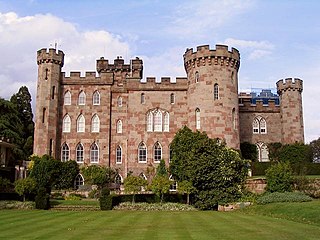
Cholmondeley Castle is a country house in the civil parish of Cholmondeley, Cheshire, England. Together with its adjacent formal gardens, it is surrounded by parkland. The site of the house has been a seat of the Cholmondeley family since the 12th century. The present house replaced a timber-framed hall nearby. It was built at the start of the 19th century for George Cholmondeley, 1st Marquess of Cholmondeley, who designed most of it himself in the form of a crenellated castle. After the death of the Marquess, the house was extended to designs by Robert Smirke to produce the building in its present form. The house is designated by English Heritage as a Grade II* listed building.

Burton Hall is in the small village of Burton, 2 miles (3 km) to the southeast of the larger village of Tarvin, Cheshire, England. It is recorded in the National Heritage List for England as a designated Grade II* listed building.

Belmont Hall is a country house one mile (1.6 km) to the northwest of the village of Great Budworth, Cheshire, England. It is recorded in the National Heritage List for England as a designated Grade I listed building. The house stands to the north of the A559 road. Since 1977 it has been occupied by Cransley School.

Utkinton Hall is a country house to the southeast of the village of Utkinton, Cheshire, England. It is recorded in the National Heritage List for England as a designated Grade I listed building.
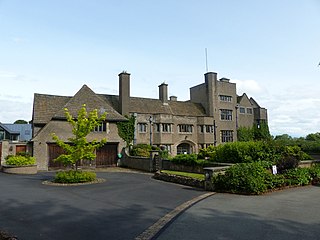
Tirley Garth is a large country house some 2.5 miles (4 km) to the north of Tarporley, Cheshire, England. The house together with its entrance courtyard walls are recorded in the National Heritage List for England as a designated Grade II* listed building.

Cogshall Hall is a country house near the village of Comberbach, Cheshire, England. It was built in about 1830 for Peter Jackson. A kitchen wing was added to the rear during the early 20th century. It is constructed in red-brown brick, and has a slate hipped roof. It is rectangular in plan, and has two storeys. Its architectural style is Georgian. The entrance front has five bays and an Ionic portico. There is a similar, smaller portico on the right side. The house is recorded in the National Heritage List for England as a designated Grade II* listed building. The lodge to the hall was built at about the same time. It has a Tuscan porch with a pediment, and is listed at Grade II. The architectural historian Nikolaus Pevsner refers to the lodge as being "ambitious".
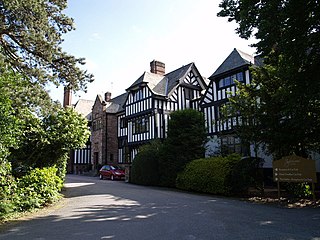
Inglewood is a house to the north-west of the village of Ledsham, Cheshire, England. It was built in 1909, but is dated 1915. The house was built for Frederick H. Fox, a Liverpool millionaire who made his fortune in marine insurance. It was later one of the seats of the Gordon family. As of 2011 it is a hotel called Inglewood Manor Hotel. The house is mainly half-timbered, with stone dressings, and brick chimneys decorated with diapering. It is roofed with Lakeland slate. Its architectural style is late Arts and Crafts. The house has a rectangular plan, with three fronts in two and three storeys. The entrance is on the east front, which has eight bays; the south and west fronts each have five bays. On the south side is a balcony overlooking the gardens. The house is recorded in the National Heritage List for England as a designated Grade II listed building. Also listed Grade II are the south and west terrace walls of the garden, and the east terrace walls and a pergola.

The Old Hall is a country house in the village of Mobberley, Cheshire, England. It was built in 1612 and extended later in the 17th century. The house stands in gardens which retain part of the moat and ancient yew trees. The house is recorded in the National Heritage List for England as a designated Grade II* listed building, and the grounds contain two Grade II listed buildings.

Shotwick Hall is a former manor house in the village of Shotwick, Cheshire, England. It replaced an earlier manor house that stood on a moated site some 150 metres to the west. The hall and four associated structures are listed buildings, and the moated site is a Scheduled Monument.

Stretton Hall is a country house in the parish of Stretton in Cheshire, England. It was built in about 1763 for John Leche. The house is constructed in brick on a sandstone basement, with painted stone dressings, and a slate roof. It has three symmetrical elevations. The entrance front is in three two-storey bays with a single-storey wing on each side. The central bay is canted, with five steps leading up to a doorway with a pediment. The windows are sashes. The garden front has similar windows, other than the wings, each of which contains a Venetian window. To the right of the house is attached a further wing, converted from the 17th-century stable of an earlier house. The house and former stable area is recorded in the National Heritage List for England as a designated Grade II* listed building. The sandstone garden walls are listed at Grade II.
Tattenhall Hall is a country house standing to the south of the village of Tattenhall, Cheshire, England. The house is designated by English Heritage as a Grade II* listed building.

Willington Hall is a former country house in the parish of Willington, Cheshire, England. It was extended in 1878, but reduced in size in the 1950s, and has since been in use as a hotel.
Willington is a civil parish in Cheshire West and Chester, England. It contains nine buildings that are recorded in the National Heritage List for England as designated listed buildings. Of these, one is listed at Grade II*, the middle grade, and the others are at Grade II. The parish is entirely rural, and contains two listed country houses, Tirley Garth and Willington Hall, both of which are listed. The other listed structures are associated with these houses, plus a farmhouse.
Macclesfield Forest and Wildboarclough is a civil parish in Cheshire East, England. It contains 28 buildings that are recorded in the National Heritage List for England as designated listed buildings. Of these, two are listed at Grade II*, the middle grade, and the others are at Grade II. Population in the parish is scattered, and most of the parish is farmland, moorland and forest. There are two small settlements at Wildboarclough and Allgreave, otherwise dwellings are scattered. The major house in the parish is Crag Hall; this and buildings associated with it are listed. Other listed buildings include farmhouses, farm buildings, churches, a terrace of houses, a bridge, a former post office with a telephone kiosk outside it, milestones, mileposts and parish boundary stones.
Tatton is a former civil parish in Cheshire East, England. It contained 26 buildings that are recorded in the National Heritage List for England as designated listed buildings. Of these, one is listed at Grade I, the highest grade, two are listed at Grade II*, the middle grade, and the others are at Grade II. The major building in the parish was Tatton Hall, and all the listed buildings in the parish are related to it. These include the hall itself, Tatton Old Hall, the Home Farm, structures in the gardens and park, and lodges at the entrances to Tatton Park.